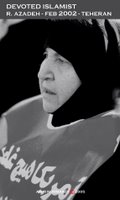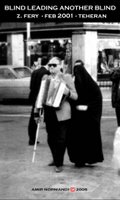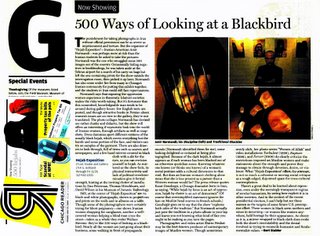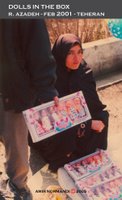500 Ways of Looking at a Blackbird









 ..."Still, at the center of Hejab Exposition" are its black-and-white photographs, shown in projections and prints on the walls and in albums on a table. Though some of the photographers were certainly trying to blunt poignancy - one shows Iranian women shopping for sunglasses, another a well covered women helping a blind man cross the street - taken as a whole they evoke Wallace Stevens: they're like 500 ways of looking at a black murals (Normand identified them for me), some looking delighted or irritated at being photographed. Because of the dark hejab, it almost appears as if each woman has been blacked out of an otherwise quotidian scene. Knowing whatever one knows (or thinks one knows) of a woman's social position adds a cultural dimension to that void. But does an Iranian woman's clothing alone mean that she is less present as a person than a Western woman would be? The press release quotes Ezzat Goushegir, a Chicago dramatist born in Iran, as saying, "While hejab by force is an act of oppression, hejab by choice is an act of democracy." (Of course that oversimplified statement ignores the ban on Muslim head scarves in French schools.) Goushegir goes on to say that the show "explores both sides of the tradition." But Normandi actually just puts the tradition in a photo album in your lap and leaves you not knowing what kind of face you ought to be making as you turn the pages."
..."Still, at the center of Hejab Exposition" are its black-and-white photographs, shown in projections and prints on the walls and in albums on a table. Though some of the photographers were certainly trying to blunt poignancy - one shows Iranian women shopping for sunglasses, another a well covered women helping a blind man cross the street - taken as a whole they evoke Wallace Stevens: they're like 500 ways of looking at a black murals (Normand identified them for me), some looking delighted or irritated at being photographed. Because of the dark hejab, it almost appears as if each woman has been blacked out of an otherwise quotidian scene. Knowing whatever one knows (or thinks one knows) of a woman's social position adds a cultural dimension to that void. But does an Iranian woman's clothing alone mean that she is less present as a person than a Western woman would be? The press release quotes Ezzat Goushegir, a Chicago dramatist born in Iran, as saying, "While hejab by force is an act of oppression, hejab by choice is an act of democracy." (Of course that oversimplified statement ignores the ban on Muslim head scarves in French schools.) Goushegir goes on to say that the show "explores both sides of the tradition." But Normandi actually just puts the tradition in a photo album in your lap and leaves you not knowing what kind of face you ought to be making as you turn the pages."










 |
|

<< Home